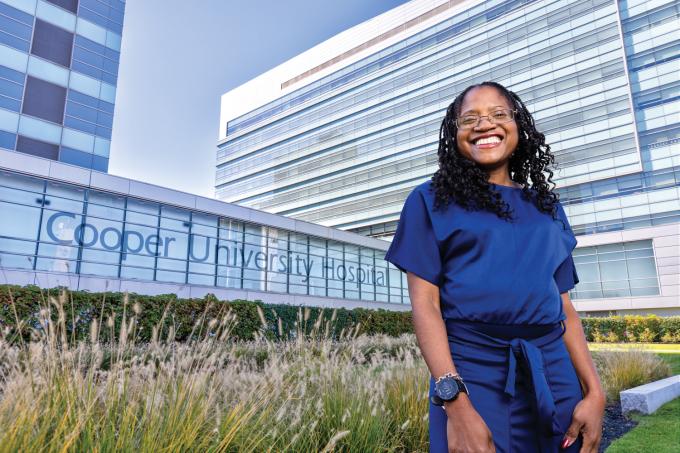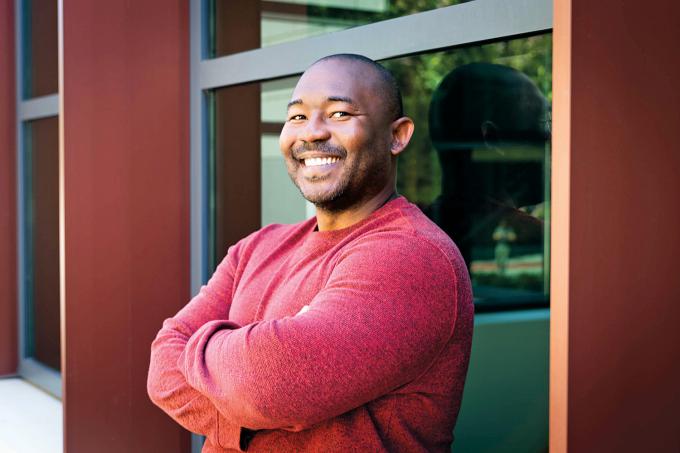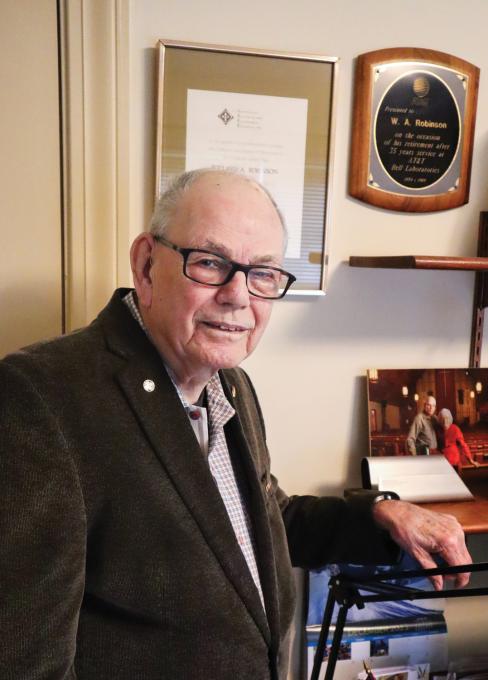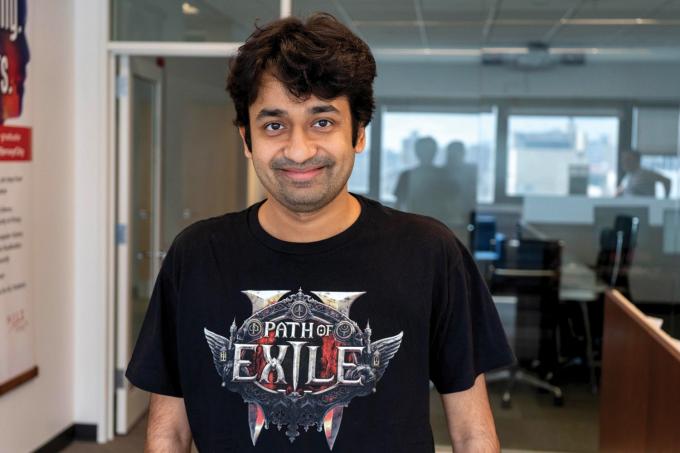Alumni News
A profile of NJIT Alumni.

Krystal Hunter ’21 Ph.D.
A Statistician Delves into Health Disparities
Biostatistician, Cooper Research Institute
Associate Professor, Cooper Medical School of Rowan University
Q: What is your role as the lead biostatistician for a research hospital?
A: If a physician notices a phenomenon in a segment of the patient population, he or she may initiate a research study to examine the characteristics of those affected by it. A surgeon may notice, for example, a high rate of surgical site infections with a type of suture. As a biostatistician, I help set up the statistical plan for the study, including the statistical tests that will be run to test the hypothesis. I also provide a sample size to ensure that there is enough data within the study to avoid a false negative result due to a lack of sample. At the end, I analyze the numbers using the methodology I outlined. I also help administer survey studies where I quality-check the data looking out for double-barreled or confusing questions in research and process improvement surveys of patients and staff.
Q: What’s at stake?
A: Making sure that we collect the correct data that will enable the team to answer their research question. What if we spend years collecting data and can’t use it? Not only does that waste resources, it also can present an ethical issue as we either exposed study participants to risk without reporting a result or we risked confidentiality when doing a review study of health records. It’s also important that we look at the collected data and are aware of confounders. Let’s say we’re looking at the relationship between the outcome of chronic pain and age and find a statistically significant relationship between the two. But we also have another explanatory variable of arthritis. People with arthritis tend to be older. This bears the question: Is it truly age that is affecting chronic pain or is it the age-effect of arthritis?
Q: What is your focus as a researcher?
A: I’m focused on health disparities, and birth outcomes in particular. With preterm births, for example, there’s always been a disparity between white women and Black women, who are at higher risk. This includes Black women with high economic status. The gap between high and low economic status white women is large, but it’s much tighter with Black women. Foreign-born Black women from sub-Saharan Africa have comparable rates of low-birth-weight babies with white women. Unfortunately, a study of low birth weight showed that foreign Black women were the only group where with each succeeding generation, their risk increases. The goal is to bridge those gaps.
- Tracey L. Regan

Sanmi Koyejo ’05
Bias, Diversity and Truth in AI
Assistant Professor of Computer Science, Stanford University
Co-Founder and President, Black in AI
Q: Should we be alarmed about the rise of AI?
A: AI has been around for a long time and its deployment is ubiquitous. Almost every online platform has some automated decision making: Google web searches; fraud detection; and hiring decisions based on automated systems. What has changed recently, in the public consciousness at least, is that ChatGPT and OpenAI got released and people saw that these tools seemed to work well, but also in a way they could engage with easily. I’m trying to make sure that the impact on society is more beneficial than not.
Q: How can you counter bias?
A: The way these tools are built depends strongly on the data that exists, so behavior in the past is used to make predictions about behavior in the future. This can be problematic, as in decisions that are correlated with past histories of discrimination. It shows up in a benign way in how different video cameras work for people with different skin tones, but it also shows up in police applications that make more mistakes on people with darker skin tones and can result in people being in prison incorrectly. Having people in the room that have different lived experiences, not just diversity of thought, has a direct impact on building tools that work for everyone.
Q: Can AI help us detect biases in health care that affect outcomes?
A: Unfortunately, a lot of the history of medical care has systemic biases of different care being administered to different groups, sometimes by demographics and sometimes by wealth status. It’s sometimes hard to tell which differences are biological and which are due to the biases of the decision makers. We were looking at care around COVID and found systematic differences in care and outcomes that were tied to demographics. An interesting finding was that language seemed to be a really good predictor of who got better or worse care. If people came in and they didn’t speak English sufficiently well, their care was systematically worse, their outcomes were systematically worse.
Q: What prompted you to be a founding member and current president of Black in AI?
A: Circa 2016, a few of us who came together with the shared experience of being the only Black person we knew working in the field. At the time, some impacts of technology could be explained by the fact that there was no one in the room with the lived experience to speak to a tool being built that would have a worse outcome for certain demographics. We’re about 5,000 people now and international. It’s rewarding to hear stories from people who tell us they would not be in the field if they had not engaged in the group early on, and they’ve gone on to have incredible careers.
- Thomas Kertscher
Photo: Ananya Navale

Willard Robinson ’62
An Engineer Gives Back
When Willard Robinson graduated from Newark College of Engineering (NCE) in 1962, he was at the top of his class. Now 92, he’s been giving an annual gift to NJIT for a remarkable 50 straight years.
After high school, Robinson enlisted at 17 and became an electronics technician on a Navy destroyer during the Korean War. After the Navy, he got an associate’s degree in radio engineering, which led him to being recruited by Bell Labs in 1954. He worked in the military systems lab as a technical assistant on radar and anti-ballistic missile systems.
One of the projects he tackled was improving the range unit for radar systems. This new design, which he shared a patent for, was used in a system that guided satellite launches from Cape Kennedy in Florida.
Seeing that his employer valued education, Robinson enrolled at NCE. At the time, he and his wife had been married for just a year. Living in West Orange, where his wife Joyce was a high school teacher, Robinson would leave work and then attend classes four nights a week, until 10 p.m. Then, after a bus ride home, he would study at a small desk set up in the hallway of their second-floor apartment for another hour and a half. The schedule was grueling, and his new bride once said to him, “I’m not sure we’re going to know if we’re even compatible — I hardly see you!” They ended up being married for nearly 70 years.
Once he graduated from NCE, Bell Labs rehired him as a member of the technical staff and put him into their Graduate Study Program. He went on to earn a master’s degree in electrical engineering from NYU.
In 1971, Bell Labs moved his division to work on a new microwave radio relay system for AT&T that would be built in North Andover, MA. He and his family relocated there, where he still lives. He has four children: an engineer, an architect, a special education teacher and one that is retired.
In 1982, Robinson received one of the first new “sustained individual performance” awards at Bell Labs. The award was given — not to a manager — but to a seasoned, high performing engineer who excelled in their work. Bell Labs offered Robinson a retirement package in 1989, when he was 58.
At the time, Robinson had been getting more involved in his local church and soon began volunteering at a middle school in the nearby town of Lawrence, which had a large number of immigrant students. After volunteering in a Saturday math program, Robinson was asked to help the school’s science teachers and did hands-on science experiments. Later he got more involved in district-wide science programming and training teachers; he ended up volunteering with the schools for 20 years.
Thinking back to his time at NCE, Robinson said he remembers one of his classes going into Manhattan to see Inherit the Wind and then coming back to campus to discuss it. He credits another class — a labor relations course he took his senior year — with turning him into “a liberal.” Robinson said NCE’s approach was that students were engineers first, then an EE, ME, or CE second. Because of that, students were required to take a wide variety of courses in other engineering disciplines than the one in which they were majoring. Robinson said he found that was helpful in his career.
“I never thought of not giving back to NJIT for my fine education,” he said.
- Theta Pavis
Photo: Courtesy Willard Robinson

Hrishi Sidhartha ’15
‘Grinding Gears’ in a Job Most Gamers Dream About
Hrishi Sidhartha ’15 turned an elective into a career to envy.
As a game designer with Grinding Gear Games, he spends his day shaping Path of Exile 2, one of the most anticipated action role-playing games on the market. He had to relocate to the other side of the world — or at least down under — to join the Auckland, New Zealand-based company, but making necessary life adjustments was literally in the name of the game when he was offered a once-in-lifetime opportunity.
“One of my main roles is working on the itemization of the game. This involves working on everything to do with items that drop in the game, including all the really wacky ones. It’s a highly creative role, and I love it,” he said.
Sidhartha recently returned to NJIT for the first time since moving seven years ago, as a special guest speaker for Senior University Lecturer DJ Kehoe’s IT 266 Game Mod Programming, the class where it all began for him. He credits Kehoe with sparking the inspiration to change majors from computer science to information technology.
“I knew Professor Kehoe’s class would be fun, but I didn’t expect to learn as much as I did. I wound up learning more through him than in any other class. IT 266 became my favorite because it was so useful.”
As one would expect, the road to finding his dream job was anything but simple. “I was lucky — but I also worked hard. I had sent out around 500 applications to get to the No. 1 job at the No. 1 company I wanted, which was the first one I applied to!” Sidhartha continued.
Sidhartha feels that he may have had a slight advantage over other job candidates because Kehoe’s class was “not just talking,” but required students to build a competitive portfolio. Nevertheless, Kehoe also places great importance on developing the art of interviewing, including the confidence to speak in detail about a project and the depth of knowledge to answer the most difficult, unforeseen questions. His class also uses engines that are standard in the gaming industry.
When asked to offer some insight on creating a successful career in gaming, Sidhartha advises finding ways to stand out. “And definitely don’t underestimate a class requiring you to make a game full circle. It’s a big challenge, but so is the pay off,” he said.
Last, but not least, have a thorough understanding of the company and their product, stay current on what’s new — and, of course, “play a lot of games!”
- Michael Giorgio
Photo: Courtesy Hrishi Sidhartha